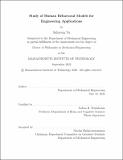| dc.contributor.advisor | Tenenbaum, Joshua B. | |
| dc.contributor.author | Yu, Suhyoun | |
| dc.date.accessioned | 2023-01-19T19:52:11Z | |
| dc.date.available | 2023-01-19T19:52:11Z | |
| dc.date.issued | 2022-09 | |
| dc.date.submitted | 2022-10-05T13:47:24.179Z | |
| dc.identifier.uri | https://hdl.handle.net/1721.1/147463 | |
| dc.description.abstract | Input from and interaction with humans is quickly becoming an inseparable part of designing critical systems: electrical power grids are evolving into smart grids that allow for two-way communication between utilities and their users, and the demand for seamless human-robot collaboration in warehouses and urban rescue missions is ever-increasing. As such, proper understanding and modeling of human decision making behavior should be an integral part of designing critical systems. Unfortunately, in the traditional engineering context, humans have been assumed to be rational agents that behave in the way they ought to, rather than the way that they actually do.
This thesis lays the groundwork for incorporating a more general model of human decision making in engineered systems to improve the quality of interaction between a system and its users, and as a result, its overall performance and reliability. We investigate three computational principles known to influence human behavior: noisy utility maximization, discounting, and the probability weighting principle from Prospect Theory. We evaluate their individual and combined effects in the context of a naturalistic spatial planning task that required sequential decision-making. This task presents challenges that will occur across general contexts. All model selection analyses used show that a significant majority of human subjects’ trajectories are best explained by models with discounting and, in particular, probability weighting.
We conclude with a simulation of a simplified 2D urban rescue mission, which demonstrates that these more realistic assumptions about human behavior reduce the cost to complete the collaborative mission by ∼ 13%. The results reinforce the hypothesis that a more nuanced model of human behavior is critical for systems that heavily interact with humans. Better models better complement real human behavior and therefore enhance the overall efficiency and performance of a given system. | |
| dc.publisher | Massachusetts Institute of Technology | |
| dc.rights | In Copyright - Educational Use Permitted | |
| dc.rights | Copyright MIT | |
| dc.rights.uri | http://rightsstatements.org/page/InC-EDU/1.0/ | |
| dc.title | Study of Human Behavioral Models for Engineering Applications | |
| dc.type | Thesis | |
| dc.description.degree | Ph.D. | |
| dc.contributor.department | Massachusetts Institute of Technology. Department of Mechanical Engineering | |
| mit.thesis.degree | Doctoral | |
| thesis.degree.name | Doctor of Philosophy | |
